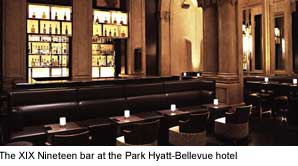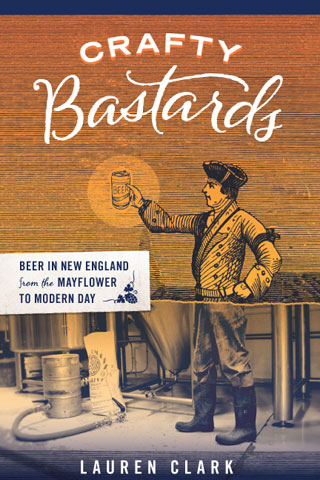Archive for February, 2007
February 7th, 2007
Today’s New York Times features a great, quote-rich article on London’s cocktail scene, The Best Town to Make an Upper Lip Stiff. I want to point to an excerpt that encapsulates the philosophy and mission of drinkboston.com:
Of course, lemon grass and ginger syrup in the hands of the wrong bartender can lead to disaster. Few people understand this better than Robbie Bargh, the creative director of the Gorgeous Group, the consulting concern behind many of London’s splashiest new joints. An ebullient, opinionated former mixologist and bar manager with 16 years’ experience, Mr. Bargh said he has no time for “egotistical demigods” behind the bar who don’t bother with the fundamentals.
“We’re going through a big backlash to over-mixology,” he said. “I think like a chef. Like a chef, you can’t deliver innovation without renovation. You can’t modernize without a basic understanding of what it takes to make a great classic drink — why a Negroni is so different made with Aperol rather than Campari.”
In short, if you go to a bar where the bartender doesn’t know how to make a Negroni but instead offers you an Earl Grey-Chocolate-Chipotle Pepper-tini, pause and ask yourself: would I spend my money at a restaurant where the chef could whip up all manner of trendy foams and sculptural appetizers but couldn’t grill a steak to save his life? If your answer’s no, then move on to the next bar.
Posted in Booze in the news, Cocktails | 1 Comment »
February 4th, 2007

Meet Me in the Bar: Classic Drinks from America’s Historic Hotels, by Thomas Connors, is a travel guide for the cocktail tourist. The book lovingly describes a couple dozen or so grand, old hotel bars, along with signature drinks concocted therein. Representing Boston are the Oak Bar at the Fairmont Copley Plaza and the bar at the Ritz-Carlton. Philadelphia, where we spent a recent weekend, has the Library Lounge in the Park Hyatt at the Bellevue. Or at least it did in 2003, when Meet Me in the Bar was published. We should’ve called first.
Ironically, Connors writes of the Library Lounge, “These days, as hotel operators jazz up old properties for a younger clientele, it’s possible to walk into a sober-looking hotel and discover that that sensible bar you once knew is now a scene. Luckily, the 19th-floor Library Lounge is nothing like that.” He goes on to describe its intimate scale, its rich woodwork, its fireplace and its book-lined walls. Sigh. That would have been great. The brand new bar that we found in its place, XIX (aka Nineteen), has most decidely been “jazzed up for a younger scene.” The only thing that remains from the Library Lounge is a large painted portrait of a well-to-do Quaker ice skating.
XIX is a posh but beige bar that could be in any first-class hotel in America. Sure, it’s a nice, polished-marble oasis high above the city, and the bartender was a welcoming and competent guy who had just moved up from Baltimore. But he had never heard of a Clover Club. That drink — gin with egg white, lime, raspberry syrup and bitters — originated at the Bellevue, and Connors calls it “the spiritous equivalent of the famous Philly cheese steak.” Unfortunately, the Clover Club seems to have gone the way of the books that once lined the walls of this bar. Vodka is now the dominant spirit on the cocktail menu, as it is in every other posh hotel bar in the country. At least they had Yuengling Lager.
Posted in Philadelphia | 2 Comments »
February 2nd, 2007
 A couple of months ago, a guy named Goran Berntsson emailed me and asked, “Would you kindly answer my question on Sidecars? I wonder about the word ‘Boston’ in ‘Boston Sidecar.’ Does it just mean the drink is shaken in a Boston shaker or is there anything more, something historical, behind ‘Boston’ in this connection? I do think there should be, but if so: What?”
A couple of months ago, a guy named Goran Berntsson emailed me and asked, “Would you kindly answer my question on Sidecars? I wonder about the word ‘Boston’ in ‘Boston Sidecar.’ Does it just mean the drink is shaken in a Boston shaker or is there anything more, something historical, behind ‘Boston’ in this connection? I do think there should be, but if so: What?”
I had no idea. How embarrassing — drinkboston.com had never heard of a Boston Sidecar. I found the recipe in the Old Mr. Boston De Luxe Official Bartender’s Guide (1961 edition) I received for Christmas: 3/4 oz brandy, 3/4 oz rum, 3/4 oz triple sec, and the juice of half a lime shaken on ice and strained. But I didn’t know why it was called the Boston Sidecar. I asked around, but none of my bartender pals had any answers about the drink’s origins. I was only able to tell Goran that the Boston shaker likely had nothing to do with the drink’s name, since most cocktails are mixed in this apparatus. I noticed that Goran asked the same question on squidoo.com but didn’t get an answer there either.
Which brings me to the fact that I still have no background on this drink, but that this site ought to at least compile a list of drinks either with “Boston” in their name or that originated here. Here are a few:
- Boston Sidecar (recipe above)
- Boston Cocktail (from Michael Jackson’s Bar & Cocktail Companion: 1.5 oz dry gin, 1 oz apricot brandy, 1 tsp lemon juice, dash of grenadine)
- Ward Eight (probably the most famous forgotten Boston cocktail. From CocktailDB: 1.5 oz bourbon or rye, 1 oz lemon juice, 1 tsp sugar, 1/4 oz grenadine)
Of course, it being the Old Mr. Boston guide, that book has recipes for the Boston Collins and the Boston Sour, but those appear to be simply variations on the Rum Collins and the Whiskey Sour. I’ll do some cross-referencing and start a page of Boston cocktails whose recipes come from more than one source. In the meantime, if anyone knows how the Boston Sidecar, or the Boston Cocktail for the matter, got its name, chime in under Comments, will you?
Posted in Brandy, Cocktails, Gin, Rum, Whiskey | 4 Comments »

 A couple of months ago, a guy named Goran Berntsson emailed me and asked, “Would you kindly answer my question on Sidecars? I wonder about the word ‘Boston’ in ‘Boston Sidecar.’ Does it just mean the drink is shaken in a Boston shaker or is there anything more, something historical, behind ‘Boston’ in this connection? I do think there should be, but if so: What?”
A couple of months ago, a guy named Goran Berntsson emailed me and asked, “Would you kindly answer my question on Sidecars? I wonder about the word ‘Boston’ in ‘Boston Sidecar.’ Does it just mean the drink is shaken in a Boston shaker or is there anything more, something historical, behind ‘Boston’ in this connection? I do think there should be, but if so: What?”